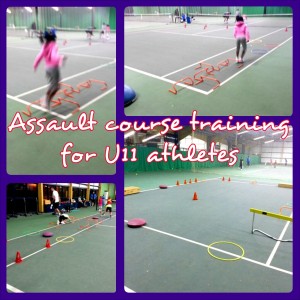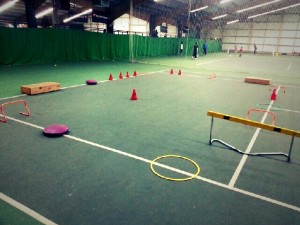Athlete led learning for U11's – Problem solving in a multi-task environment
APA coaches have been working with young athletes for the past 15 years, ages start from 4 years upwards. Coaching of young children requires a very different approach to coaching adolescent or adult athletes. Engagement in the activity is a key factor and making the sessions fun will ensure the child wants to continue learning. Mixed in with all this from an S&C coaches’ view point is the need to improve some of the physical qualities of the young athlete. APA operates itself around 5 key principles: Skill, Speed, Strength, Suppleness and Stamina. These key areas are expressed differently with different age groups and have different levels of importance based on the individual needs of the athlete and the current stage of training they are at.
At U11 level we focus on developing an all round great athlete by improving their fundamental movement skills; this includes the ability to balance, co-ordinate themselves in relation to objects and to synchronise movements. Our role as S&C coaches is to improve these areas so that it translates to improved sporting success. One of the centres APA currently works at is Gosling Sports Park, home to one of only four International high performance centres for tennis in the country. Gosling has over 500 children accessing the centre to learn how to play tennis and to improve their play, both physically and tactically. APA S&C coaches work with young athletes on a daily basis and one of the current themes of work has been focused on balance, locomotive synchronisation (different types of movement such as running, skipping, carioca, side shuffles and hopping) and rhythm. As S&C coaches we like to have a quantifiable measure of athleticism and performance. Wobble cushion balance, and agility run and skipping have been used to measure the three areas of improvement recently. Initial training involved static balancing, learning of different types of movements and various skipping challenges. There was a mixed ability amongst the young athletes and thus as expected they all improved at their own individual rates, however upon re-testing all of them had either learnt new skills, whereby they previously couldn’t skip or do carioca or side shuffling. Or they had improved the level to which they could co-ordinate their own bodies to skip, move and balance.
This has led to our next themes for work over the 6 weeks leading up to the Christmas break. Dynamic balance – including stopping and landing mechanics will be the progression from static balance, reactive agility and movement will enhance the learnt locomotive skills and crawling patterns will begin to develop some ‘functional’ strength. APA has invested vast amounts of time into developing the curriculum we use to enhance our young players’ athleticism, however we do not get vast amount of time to deliver all of the coaching aspects that we want to improve on. This is where the expertise of the APA coaches Daz Drake (founder of APA), Martin Skinner, Dom Boyle and myself (Fab Gargiulo) comes into play. We use innovative and intuitive methods that for example with the U11 academy players, can encompass a vast amount of training, learning and development into a short amount of time. I work predominantly with the U11 age group and as part of a tennis squad session will get 20mins per group to work with and improve their physical proficiency.
A method I have recently been using to great effect with the young athletes is to combine many of these areas of focus into an assault course. This works on many levels; firstly the exciting nature of having lots of equipment to use (as well as the coaching) keeps the children engaged in the tasks, making the assault course challenging. Placing restrictions on how they can move about engages them to think for themselves and to problem solve. Finally, building in team work and competition encourages them to focus and do their best and most importantly from the coaches perspective is that all of the aspects you want to improve can be covered. The structure of the course can be changed every week/session and can have different aims of focus. Currently as balance is a key area for improvement my young athletes are working on staying on a line whilst navigating obstacles with a few coach led constraints in place such as; not being allowed inside a hoop or having to face in one direction at all times. However the emphasis on this type of task is for the athletes to lead their own learning and discovery often by trial and error. To some children this comes naturally, to others less so. The ability for them to problem solve whilst doing an athletic task will have great translation across other aspects of their later lives, but also works very well in a sporting context, particularly an individual sport such as tennis, where the player is not allowed to receive any coaching whilst playing and must overcome many psychological barriers as well as physical demands in order to be successful. Part of the training is aimed at the young athletes ability to think for themselves and I consider this a key component to developing mental strength for later challenges. The children have loved the training so far, the aspects of training that have been targeted are improving all while being very engaging and challenging to the athletes – something I like to describe as ‘hiding the vegetables’.
As with most coaching techniques there is a trade off between the depth of work done on a single aspect of fitness versus covering many areas at once. The rationale for the method of work I am currently using is that many areas need to be covered in a short space of time and with varying levels of athlete all working at the same time. During individual sessions I will spend greater time on specific areas, but the group sessions have worked well with a continued variance in activity and lots of activity. As a team of S&C coaches at APA we have discussed this topic on several occasions without drawing a definitive conclusion and I believe that there is no single way to ‘skin a rabbit’ but that varied approaches should be considered dependent upon the situation.
Taking different approaches towards training outcomes will always be a discussion point, so we’d love to hear from you online or at one of the forthcoming APA workshops with your view points. Hopefully this quick article has highlighted the innovative ideas we have at APA and how we work to achieve the maximum potential out of all our athletes, as young as 4 years old.
Thanks for reading, be sure to check out www.athleticperformanceacademy.co.uk for more information on APA training and connect with us via twitter and facebook.
Fabrizio Gargiulo


